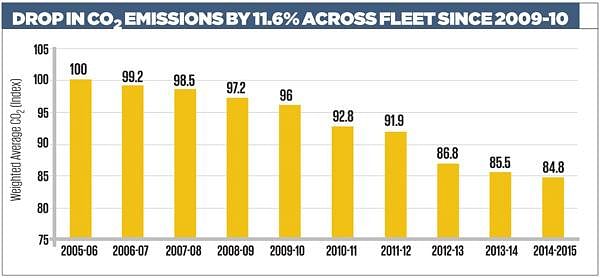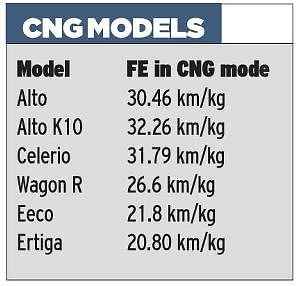Maruti strives to develop greener cars
India's largest carmaker, which has reduced CO2 emissions across its range of passenger cars, looks to increase its focus on hybrids and clean technology in the future.
At the Geneva motor show in March 2015, Suzuki Motor Corp, Maruti Suzuki India’s parent company, had exhibited three futuristic technologies – a new-generation lightweight platform, a new downsized direct-injection turbo petrol engine called Boosterjet and the SHVS mild hybrid system.
These future-ready technologies are part of the Japanese carmaker’s plan to cut down on emissions with an overall target of being non-polluting while stepping up vehicle performance.
Maruti Suzuki India has said it has been successful in scaling down the weighted average of CO2 emissions by over 11.6 percent across its product portfolio over the last five years. This has been enabled by a concerted effort at upping fuel efficiency, reduction of exhaust emissions and development of alternate fuel products.
The growing level of emissions and, as a result, air pollution, has taken a toll on Indian cities. Last December, the central government finally took a step forward to rein in the growing pollution in cities like Delhi-NCR where the transport sector has received flak for being a contributor, albeit a small one. The Faster Adoption and Manufacturing of (Hybrid &) Electric Vehicles (FAME) initiative, announced on April 1, 2015 is also another government-led effort at cleaning up the air.

The first mover
In 2006, Maruti Suzuki, the country’s largest carmaker, became the first in India to manufacture factory-fitted CNG cars. At present, this stable of cars comprises six dual-fuel (CNG and petrol) models like the Alto, Alto K10, Celerio, Wagon R, Eeco and Ertiga. The CNG variants of the Alto K10 and Celerio were launched in 2014-15. They are powered by the company’s intelligent gas port injection (i-GPi) technology which is claimed to deliver best-in-class fuel efficiency, besides safety and performance.
According to Maruti’s sustainability report of 2014-15, these eco-friendly models have been complemented on the manufacturing front by process enhancements for emission reduction, use of solar energy at its manufacturing facilities as well as cleaner fuel for electricity production.

In fact the company’s recent models, product upgrades and minor refreshes have given a further leg up to fuel savings while trimming emissions. A case in point is the Ciaz hybrid sedan, the Celerio auto gear shift or the CNG Ertiga. “With auto gear shift technology, the company is able to offer the convenience of an automatic without the need to emit more,” Kenichi Ayukawa, managing director and CEO, had said at the time. “Going forward, we will continue our focus on investing in new technologies and strengthen our capability to bring down emissions per vehicle by enhancing fuel efficiency of our cars.”

Maruti’s three most fuel-efficient cars in India are the Celerio, Dzire and Ciaz, on which the carmaker has made several innovations – introducing changes in the engine hardware to improve thermal efficiency and engine calibration, optimised transmission gear ratios for better drive and fuel efficiency, improved aerodynamic styling and weight reduction, made the combustion chamber more compact, enhanced compression ratios on petrol engines, adopted an advanced thermal management system along with low friction engine oil and modified the fuel injection system that has assisted a faster warm up to improve the diesel engine efficiency. It has also adopted a new-generation alternator management system to optimise the charging of battery through the alternator that has contributed to a better fuel efficiency.

Interestingly, Maruti Suzuki entered the full hybrid segment with its SX4 sedan in 2010 offering 10 vehicles as a pilot project for the Commonwealth Games that year. That was the first time the auto gear shift was tested in a Maruti car and the Celerio AGS became an extension of that learning. Though the programme for the hybrid SX4 was discontinued thereafter, the carmaker has been working on a pilot for its electric hybrid Swift Range Extender as part of its futuristic technology programme.
Under the National Electric Mobility Mission Plan 2020 (NEMMP), the carmaker developed the Swift Range Extender (RE-EV) which is an electric vehicle with an engine-driven generator. The vehicle functions like a pure battery-electric vehicle (BEV) for customers who commute short distances. Once the battery power is depleted, the on-board IC engine starts functioning and runs the generator for supplying power to the electric motor, thereby eliminating the range anxiety issue associated with BEVs. The vehicle can be charged at home from a household power outlet. The car is powered by a 660cc IC engine and electric motor, has an EV range of 25.5km and delivers fuel economy of 48.2km.

Mahindra & Mahindra has been equally active on the hybrid and EV front running a pilot with its e-Maxximo van at the Taj Mahal, Agra. In addition, it has in its stable the electric Verito and the Mahindra Reva e20, sales of which have been supported by the government’s financial incentives.
Meanwhile, Maruti Suzuki is believed to have developed four cars for the Swift Range Extender pilot for the department of heavy industries. But there's a cloud of doubt over its commercial viability as the cost of prototypes itself is very high. The carmaker, however, is optimistic of garnering learnings from the pilot across varied technologies that could be adapted effectively in future vehicles.
RELATED ARTICLES
Ashok Leyland's Mix of Strategy and Sustainability Ashok Leyland Aligns Sustainability Goals With Business Operations
Ashok Leyland is embedding sustainability deep into its operational strategy, leveraging green finance, electrification,...
New Players Reshape India’s Electric CV Ecosystem The Evolution of India’s e-CV Landscape
Unlike in cars and two-wheelers, the electrification of commercial vehicles is in very early stages due to uncertainty o...
Auto Giants Explore Hybrid Strategy as EVs Hit Speed Bumps
Slower-than-expected EV adoption, tight CAFE norms and ever-present efficiency demands are giving hybrids a second wind ...





 By Shobha Mathur
By Shobha Mathur
 22 Apr 2016
22 Apr 2016
 9171 Views
9171 Views





 Shahkar Abidi
Shahkar Abidi




